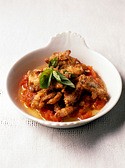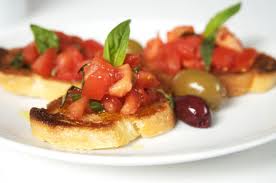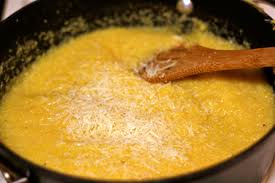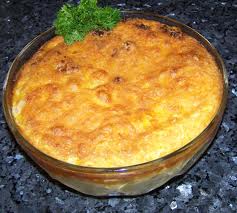I don’t usually post other people’s videos on this site, but this one is an exception. It’s a video by my friend Gregorio Uribe, musician and artist. And it’s an homage to all you fathers out there. The music is catchy but, most of all, the work is moving.
Oswald Rivera
Author, Warrior, and Teacher
Author: Oswald Rivera (page 69 of 83)
Now that summer is here, cold soups are in order. That’s right, cold soups. Back in my youth, in Spanish Harlem, we never heard of cold soups, not even in summer. It was an alien concept to us. Soups were always hot and hardy, even on the warmest of days. Then in my early manhood I discovered Vichyssoise (pronounced “vish-ee-SWAHZ” or “vee-she-swahz), a rich and creamy potato-leak soup that’s served cold. Not being too well versed at the time, I assume that it was a French dish. Then I discovered that it was, in fact, American. It was conjured up by chef Louis Diat of the Ritz-Carlton in New York City in 1917. Still, we must give the French credit since the soup most likely evolved from the leek and potato soup very popular in France, potage bonne temme. In his book, Cooking a la Ritz, Mr. Diat himself sates that the name comes from Vichy, the French town near his childhood home. He called it Cream Vichyssoise Glacee.
Since discovering this gem I’ve become a fan of cold soups in general, especially when the humid, hot weather is upon us. Vichyssoise may incorporate its own ingredients but cold soups can be made with almost any vegetable. Or fruit, for that fact. Cold soups with vegetables just need cream and whatever herbs you prefer. And all you need is a blender or food processor. Remember that you have to blend to a nice smoothness. Now, I like soups, hot or cold, on the thick side. Some prefer them a tad thinner. Just blend to the consistency you like. The important thing is the chilling—at least three hours in the fridge is essential. You can serve cold soups indoors or outdoors, even as a first course before grilling. If you want to be fancy about it, you can serve the soup in an iced tureen or chilled bowls. Or keep it cold in your thermos and chug it at work.
As for ingredients, the possibilities are endless: such greens as broccoli, spinach, zucchini, asparagus, etc.; or a white veggie such as cauliflower. Experiment—you won’t be disappointed. It’s the easiest thing to prepare.
EVERYDAY COLD SOUP
1 bunch of greens, such as asparagus, spinach, broccoli, leeks, etc. Or other vegetable such as a head of
cauliflower. The vegetables should be rinsed, drained, and cut into bite-sized pieces.
2 cups chicken broth (if you want a thinner soup, make it 3 cups)
1 clove garlic, crushed
1/8 teaspoon dried oregano or 1/4 teaspoon fresh
1/4 cup heavy cream
Salt and black ground pepper to taste.
1. Heat chicken broth in a pan, and bring to a boil. Add the vegetable, reduce heat, cover and cook 3 to 5 minutes depending upon thickness of veggie. They should be just tender.
2. Transfer to a blender or food processor. Add the garlic and oregano, and puree until just smooth.
3. Stir in the heavy cream and season to taste with salt and pepper.
4. Chill in the fridge for at least 3 hours before serving.
Yield: 4 servings.
Bruschetta (broo-sheh-tah) is just Italian bread drenched in olive oil and served with garlic and tomatoes. It goes back to at least the 15th century when folks where looking for a way to salvage stale bread. What better method than to drizzle it with olive oil and and top it with whatever was at hand? Apart from garlic and tomatoes, toppings may include basil, beans, and vegetables. According to the sources, bruschetta comes from the old Roman word bruscare (“to roast over coals”).
Some have compared bruschetta to plain garlic bread. But it’s more than that. It’s “garlic bread plus.” Now that summer is here and decent tomatoes are again available, bruschetta is a natural. I must admit that during the winter I survive on canned Italian tomatoes. Those measly specimens wrapped in cellophane just plain suck. And if you have a garden and grow your own tomatoes, you’re as close to heaven as you’ll ever be.
Bruschetta is commonly served as an appetizer (as in antipasto). But I’ve discovered you can serve it with almost any dish. I prefer it with steamed chicken—don’t know why, that’s just my thing. And since summer means grilling season, it goes great with any barbecue.
In the version given below, I’ve added black olives and roasted peppers plus Pecorino or Parmesan cheese, whatever suits your palette.
BRUSCHETTA
5 to 6 ripe tomatoes, cut into large triangles
1 medium onion, thinly sliced
1/2 cup black olives
1/2 tablespoon fresh oregano (or 1 teaspoon dried)
Pecorino or Parmesan cheese to taste, grated or slivered
3 tablespoons olive oil
1 teaspoon red wine vinegar
1 loaf Italian bread, cut at an angle into slices about 1/2-inch thick
1 clove garlic, cut in half
1 can or 7-ounce jar roasted pepper (pimentos), sliced for garnish.
1. Preheat oven to 375 degrees.
2. Place tomatoes in a big bowl.
3 . Add onion, olives and oregano
4. Sprinkle with Pecorino or Parmesan cheese.
5. Add olive oil and vinegar, and mix to blend.
7. Rub bread slices with garlic halves on both sides.
8 . Place on a cookie sheet or baking pan in the oven and bake until slices are slightly browned or golden.
9. Arrange bread slices on a platter, and top with tomato mixture.
10. Top with pimento slices and garnish around edge of platter with same.
Yield: 4-5 servings.
Back in my youth, such eateries as coffee shops and diners were known as “greasy spoons.” They were all over the place. I recall one at the corner of the elevated subway and Prospect Avenue in the Bronx. And which everyone in the neighborhood called “Los Griegos,” or “The Greeks,” since most diners, at the time, were Greek owned. There was another one on the corner of 110th street and Lexington Avenue, also called the same name by everyone around. Today there aren’t as many as before, although you can still find them in certain areas. Where I live on the East Side there is a local diner that my wife and I frequent, usually on Saturdays, when we do our errands. We have a set routine. We go to a nearby farmer’s market to get our produce, then to the Supermarket for the regular groceries, and so forth. At lunch time we have a bite to eat. I like eating at the dinner. I can get a bagel, or a tuna fish sandwich, or even an egg cream. It’s convenient, filling and cheap. Nothing fancy, just plain down-home edibles.
These days, however, we are also confronted by newer more “in” places, more “nutritionally correct” places. In my neighborhood recently, a new place has opened up that touts “organic burgers,” “organic salads,” and even “organic shakes.” It even boasts “organic wines and beer.” So this time around, my beloved wife suggested we try out the new place; that we eat “healthy” for once, rather than have the same old deal at the greasy spoon. I complied, curious to note how this new upscale place would compare. I’m always game for a new adventure.
Thus we sat in a comfortable booth in this new organic joint. The waiter or server, as they are known these days, a solicitous handsome young man, asked for our order. My wife knew what she wanted, she would try one of their organic bison burgers and a ginger ale. I ordered the usual for my Saturday noon meal, a bagel. “We have no bagels,” the server replied. This to me was weird. A New York eatery without bagels? That’s like a Catholic Church without incense. So I said, “O—kay, what have you got?” The server suggested one of their burgers, like my wife’s bison burger. Perusing down the menu I noticed they had listed portobello mushrooms. I decided on that. Then the server replied that they didn’t serve portobello burgers. “O—kay, I’ll have a portobello sandwich,” I said, and added, “on a roll.” We have no rolls,” the server informed. “You have a choice of a brioche or 2-grain bread.” Stumped, I said, “I’ll have the 2-grain bread.”
We had ordered, and we waited for our meal. My wife loved her bison burger. I, however, had a different experience. The minute I took a bite into the portobello sandwich, I couldn’t keep it down. It was the most salty thing I ever tasted. For health reasons, I avoid salt and sugar whenever I can. I seldom will grab the salt shaker at a table. This sandwich tasted like fatback. What looked like the manager of the place noticed my barely eaten sandwich on the table, and came over to ascertain what was wrong. I told him the sandwich was just too salty for my taste. He explained that could be because the portobellos had been. dipped in balsamic vinegar before cooking. I cook with balsamic vinegar. I’ve never had this taste before. Something definitely was not right. The server came back and asked if I wanted something else. I figured I didn’t want to push my luck too far, so I ordered simplest thing I could think of: two pieces of buttered. “We have no butter,” the server said. “What?” I shook my head. “No butter?” “Yes,” the server elaborated, “we don’t use butter in this establishment.”
I sat there dumbfounded. Finally I just told him to bring me two pieces of 2-grain bread. And this was my lunch: two pieces of bread washed down by water. It called to mind those tales of prisoners on Devil’s Island subsisting on the same meal; or a young Edmund Dantes eating bread and water in his island prison before he became the Count of Monte Cristo. Had I known what was coming I would have ordered the organic wine or beer. At least I could have had a buzz while dining on bread and water.
The whole experience brings to mind an old adage by the writer Nelson Algren: “Never play cards with a man named ‘Doc’ or eat at a place called ‘Mom’s.” That says it all. Sometimes the best recourse is the old greasy spoons where you can get what you want without fuss or bother. I sing their praises every day of my life.
One of my favorite nibbles is the corn meal dish called “polenta.” This is finely ground yellow or white corn meal that is cooked in boiling water until it thickens. It can be eaten as is, or leftover polenta can be baked or fried. “Polenta” is an Italian word derived from the Latin pulmentum, a term used to described various crushed grains. Ancient Romans ate versions of it known as puls. It was with the introduction of corn from the New World in the 16th century that modern polenta came into being. Prior to that time the crushed grains used included such items as flour and millet.
Polenta is known as a peasant food; and it is usually served with a sauce. Today it is eaten world-wide. In southern Austria it is eaten for breakfast; along the Adriatic Coast is is called pura or palanta and is usually served with fish. In Hungary it is prepared with sweetened milk. In South Africa, it’s eaten as a cornmeal mush called mealie pap. In the southern U.S. it’s popular as a dish called coosh, cornmeal mush that is sliced and fried and topped with maple syrup.It is also traditional in Brazil, Uraguay and Argentina, where many Italian migrated to in the 19th and 20th century.
I prefer polenta with stewed chicken or gravy. But you can serve it with sausages, mushrooms, roasted vegetables, just about anything. Given below is the traditional way of making polenta. All you need is corn meal, water and butter. Nothing could be simpler, or more satisfying.
POLENTA
3 cups boiling water
1 cup yellow corn meal
1 cup cold water
2 tablespoons butter
Salt to taste
1. Bring the 3 cups of water to a boil.
2. Combine the corn meal with the cold water, stirring to break up any lumps. Add this gradually to the boiling water, stirring constantly. Add the butter and salt and continue cooking, stirring about 15 to 20 minutes until the polenta achieves a smooth creamy texture.
Yield: about 8 servings.
 One of my all time favorite dishes is Shish Kabob (or Shish Kabab). Whether it’s Middle Eastern, Arabic or Israeli, I love the suckers. I make them with lamb, beef or poultry; in sandwiches, pita bread, or over rice pilaf or steamed white rice. But what do you do if you’re a vegetarian? Well, you can make veggie kebobs. That’s right, veggie style. And just the same way as you would prepare regular shish kebob.
One of my all time favorite dishes is Shish Kabob (or Shish Kabab). Whether it’s Middle Eastern, Arabic or Israeli, I love the suckers. I make them with lamb, beef or poultry; in sandwiches, pita bread, or over rice pilaf or steamed white rice. But what do you do if you’re a vegetarian? Well, you can make veggie kebobs. That’s right, veggie style. And just the same way as you would prepare regular shish kebob.
So, for my vegetarian friends, what follows is a vegetable kebob recipe. You can use almost any firm vegetable for this; just cut them up into pieces. You can try broccoli florets, or asparagus, or cauliflower, Brussels sprouts, or even add tofu. In this recipe I went for zucchini, cherry tomatoes, onions, pimentos, and white mushrooms. In terms of mushrooms, you can substitute portobello, cremini, oyster mushrooms, shitake or any other. Let your imagination run wild.
VEGETABLE KEBOBS
2 medium zucchini, washed, with ends cut off, and each zucchini cut into 6 slices
12 cherry tomatoes, washed and dried with paper towels
2 pounds fresh white mushrooms, washed and dried with paper towels
2 large onion, peeled and cut into eights
I large bell pepper (pimento), green, yellow or red, washed and cut into squares
1/2 cup olive oil
2 tablespoons fresh chopped parsley
1/2 teaspoon dried oregano
3 garlic cloves, finely minced
1/4 teaspoon freshly ground black pepper
1. Place vegetables on skewers, alternating vegetables.
2. Place olive oil in a small bowl. Add parsley, oregano, garlic and pepper. Mix well; and brush over all the vegetables.
3. Place skewers under the grill in an oven; or in an outdoor grill, either using a gas grill or over hot coals. Grill for about 5 minutes. Turn and grill another 5 minutes, brushing with olive mixture frequently while cooking.
Yield: 4 to servings.
“Nobody went broke underestimating the intelligence of the American people.”
—H.L. Mencken
The above quote has weighed on my mind as of late. It seems more relevant now than ever. Especially when applied to this dispute they are having in the Supreme Court over the Individual Mandate, so-called, of President Obama’s health care act. What amazes me about this controversy is how we Americans are willing to vote against our own self-interest in the name of rigid ideology. Why would anyone be against something that in the long run is beneficial to them? And the only conclusion I come to is that we, essentially, are a nation of idiots.
How else to explain this uproar? Let’s view this mandate thing logically. First of all, this was originally a conservative, Republican idea! It came about during the Clinton Administration when it first proposed national health care. The Republicans, as a counter-measure to the Clinton plan, created this idea of an individual mandate that required individuals to purchase health insurance rather than have a national single payer plan or public option (government run health program). That way the insurance companies would get loads of more individuals to sign up, and they could continue their insurance racket. A great plus for them. The ultra-conservative Heritage Foundation led the fight to approve the plan. Newt Gingrich was for it. Mitt Romney was for it (and implemented it in Massachusetts). Now, almost every Republican is against. A prime example of this hypocrisy would be Sen. Chuck Grassley (R-Iowa) who in 1994 sponsored the individual mandate. Now he is vociferously against this “intrusion into freedom.” And the reason is “why?” Simple: a Democratic president, and a black man, no less, now backs it.
Let’s view this mandate thing on its merits. It would require Americans to purchase health insurance; and, if not, they would incur a penalty. The reasoning for this is thus: for any national health plan to work it would need to cover as many people as possible otherwise it wouldn’t be profitable or practicable for the insurance companies. Without a penalty most young healthy people, who figure they don’t need insurance, would not participate. And since we’re stuck with the racket of the insurers they would be left with the sick, elderly and infirmed to cover—which would kill the insurance companies. So, how to cover the 50 million uninsured persons in the U.S.? Those who could not buy or afford insurance would be eligible for some sort of government subsidy.
There is also the responsibility question. Right now, anyone who goes to the emergency room gets treated, whether they have health insurance or not. If you don’t have any insurance, then we the taxpayers end up paying for it through our premiums. The question is: is it right for us to pay for someone who doesn’t have or doesn’t want health insurance? I’m sure if the emergency rooms started turning away those individuals without health insurance we would think differently about the plan. It’s estimated than without the individual mandate our premiums might get jacked up to $1,000.
But what gets me about this whole thing is that there are people who want the entire Obama plan repealed. That means doing away with the pre-existing option. Because of Obama’s health care plan, companies can no longer turn down a person for insurance due to a pre-existing condition. This was one of the most flagrant insults imposed by the insurers. If you suffered from a critical illness like cancer or emphysema, the insurers could turn you down because it would be too expensive for them and not profitable enough. Does anyone in his right mind want to do away with this provision? I’d like to see what a die-hard tea partyer would say if he/she or a family member had such a pre-existing condition? Or the other part of the plan whereby a family can insure a child under the plan for up to age 26. This enables the younger folks, most of whom can’t afford health care, to have some form of insurance. Again, who in their right mind would want to do away with this?
The main argument against the Individual Mandate is that it will incur state debt, which a lot of states cannot afford at the moment. But more, it will force people to buy something they don’t want as mandated by the federal government. To them this is unconstitutional, a violation of their “rights.” Yeah, their right to deny 50 million of our fellow citizens a measure of health care—something which is a right in every other developed nation except the good ole U.S. of A. For the record, I don’t like this Individual Mandate. As noted, the only ones who profit from it is the insurance companies. Yet, it’s the only compromise that would allow any kind of health care at all to pass muster at this time. I would much prefer a single payer plan of a public option. Barring that, this is the only thing that President Obama could get through a recalcitrant congress. When he campaigned as Senator Obama his plan did not include the mandate. He included it in his health program because, honestly, that’s the only way the plan would be palatable to most conservatives in Congress.
The latest opinion poles state that up to two-thirds of Americans are against the plan—even though it will afford everyone some measure of health care. Again, I go back to my basic premise: a nation of idiots.
(Note: cartoon courtesy of Coghillustration)
I’m an aficionado of canned tuna fish. Have been all my life. Like most Americans, it’s mainly been in the usual tuna fish sandwiches. You know the deal: 2 slabs of bread and tuna mixed with gobs of mayonnaise. Canned tuna has so many uses. Back in Spanish Harlem, during my salad days, we use to make a quick meal of canned tuna fish over rice. Simple and delicious. But the sandwiches remained our usual standby. And in our experimenting with tuna sandwiches we came upon our favorite: broiled tuna sandwiches (of which the recipe is given below).
It should be noted that in the U.S. 52% of canned tuna is used for sandwiches. While 22% is for salads, and 15% is for other uses such as casseroles. Canned tuna comes in 2 variations: Chunk Light and White Albacore (also known as “solid white tuna”). Chunk light tuna comes from darker species of tuna and is considered not as good as solid white. The interesting thing is that chunk light contains lower levels of mercury than albacore white and thus it’s healthier for you. According to the American Medical Association, canned tuna contains various levels of mercury. So, for young children it should be limited to no more than 2 meals a month. Whereas chunk light should be limited to 3 meals a month. All this is off-set by the fact that canned tuna is a good source of Omega-3 fats that help reduce cardiovascular disease.
BROILED TUNA SANDWICHES
2 cans (5-oz) tuna, flaked
1 cup chopped celery (about 2 large ribs)
1/4 cup mayonnaise
1 clove garlic, finely minced
1/4 teaspoon dried oregano
Freshly ground black pepper to taste
4 hamburger rolls, split and toasted (or 8 slices toast)
Grated Parmesan cheese to taste
1. In a bowl mix all the ingredients except the rolls and Parmesan cheese.
2. Spread rolls on a baking pan or cookie sheet, and spread with the tuna mix to cover. Sprinkle with Parmesan.
3. Broil about 6 inches from heat source until bubbly (about 5 minutes).
4. Cover with roll tops. Cut each roll in half and serve.
Yield: 4 servings.

I came across grits, that all-American gem, while stationed down South during my time in the Marine Corps. And I got to love them. I was, and remained hooked on grits. This archetypical Southern staple is like no other. Strange that a kid from Spanish Harlem should become so enamored of this dish but, then, why not?
Grits are of North American Indian origin. It is simply coarsely ground corn. The preferred version in the South is hominy grits. This is field corn that is soaked in lye water (what in the old days was known as potash water). The corn kernels swell to twice their size, and are then dried and ground. Hominy as an Indian food goes back to at least 5,000. When European colonists came to the Americas, the Indians taught them how to make it. Hominy comes in three varieties: fine, medium or coarse. A newer innovation, quick grits, is very fine grain that has been pre-steamed. But no real Southerner would ever eat or cook quick grits. That would be sacrilege. To them the old-fashioned stone ground gits is the real deal.
Grits comprise the typical Southern breakfast. They are nominally served with butter, sausage, country ham or red-eye gravy. The words “grits” is derived from the Old English “grytt,” meaning coarse corn meal. As such grits is similar to corn-based porridges such as the Italian polenta and the ever popular farina. Besides breakfast, grits has another use: when I was down South they would take leftover cold grits, slice it like bread and fry the slices in oil. Another way to enjoy this heavenly item.
When making grits, the rule of thumb is that grits it will consume four times their volume. So, for 1 cup of grits use 4 cups or water or chicken stock, and simmer for 20-25 minutes until the liquid is absorbed. I recall that grits was popularized in the 70s TV series Alice where the waitress, Flo, working at Mel’s Roadside Diner, would always exclaimed, “Mel, kiss mah grits!” And, just one more fact, there’s even a World Grits Festival held yearly in St. George, South Carolina.
The recipe given below is simply grits cooked with onion, garlic, nutmeg, red pepper, Cheddar cheese and eggs. Then the whole thing is baked in a casserole. Another innovative way to cook grits, and it’s scrumptious.
CHEESE BAKED GRITS
1 cup grits
4 cups boiling water or chicken stock
Salt to taste
2 tablespoons butter or margarine
1 medium onion, chopped
1 clove garlic, finely minced
1/4 teaspoon grated nutmeg
1/2 teaspoon crushed red pepper
2 cups grated sharp Cheddar cheese
4 eggs, separated
1. Stir grits into boiling water or stock. Add salt and cook until soft.
2. As the grits cook, preheat oven to 350 degrees F.
3. In a small pan, melt the butter and saute the onion and garlic until soft.
4. Add to the cooked grits along with the nutmeg, red pepper and Cheddar cheese. Stir to combine.
5. Let cool slightly and add the egg yolks. In a small separate bowl beat egg whites until stiff and they hold soft peaks. Fold into grits mixture.
6. Spoon mixture into a casserole (about 2 quarts). Here I prefer to use a cast-iron pan. But any good baking pan or souffle dish will do. Place in oven and bake for 25-30 minutes until desired degree of doneness.
Yield: Six or more servings.
 I know, you’re saying, “Frogs’ legs—what the f . . ..” Yes, kiddies, frog’s legs. That’s the recipe I want you to try. Now, hear me out. I admit, it’s most likely not your usual tidbit, and it’s mostly associated with hoity-toity French cuisine. Yet did you know that frog’s legs is a delicacy of Cantonese cooking, as well as Thai, Vietnamese, Portuguese, Spanish, Greek and Italian cuisine? Not to mention, it’s also popular in the southern regions of the U.S. In Indonesia it’s a national dish in the form of Swikee Kodok Oh, or frog’s legs soup usually served with rice. So, don’t get bummed out. It’s a favorite dish of a lot of people, not just our French brethren. Frog’s legs have a mild, enticing flavor similar to fish. They are also rich in protein, omega-3 fatty acids (the good kind), vitamin A and potassium. Figure it this way: the suckers are good for you.
I know, you’re saying, “Frogs’ legs—what the f . . ..” Yes, kiddies, frog’s legs. That’s the recipe I want you to try. Now, hear me out. I admit, it’s most likely not your usual tidbit, and it’s mostly associated with hoity-toity French cuisine. Yet did you know that frog’s legs is a delicacy of Cantonese cooking, as well as Thai, Vietnamese, Portuguese, Spanish, Greek and Italian cuisine? Not to mention, it’s also popular in the southern regions of the U.S. In Indonesia it’s a national dish in the form of Swikee Kodok Oh, or frog’s legs soup usually served with rice. So, don’t get bummed out. It’s a favorite dish of a lot of people, not just our French brethren. Frog’s legs have a mild, enticing flavor similar to fish. They are also rich in protein, omega-3 fatty acids (the good kind), vitamin A and potassium. Figure it this way: the suckers are good for you.
The historical record shows that frogs’ legs were popular in southern China as early as the first century of the Common Era. The Aztecs also had a yen for them. But, ironically, it was the Catholic Church that made them a staple in France. Early on, the church had a prohibition on eating meat on a certain number of days during the year, the most common being Friday. Gluttonous monks in France got around this by qualifying the frog as a fish, and not as a meat item. Naturally, since frogs grew wild during that time, hungry peasants got into the act by dutifully following the monk’s (and the Church’s example) and eating the frogs. And a national dish was born. They became so endemic with French cuisine that the favorite insult toward the French is referring to them as the Frogs.
The dish crossed the Atlantic by way of Louisiana, where the French speaking Cajun folk popularized it in New Orleans. And to this day they still enjoy it either deep-fried, sometimes breaded and sometimes not. Now, don’t get turned-off by it. Check out the recipe. Give it a chance. It might surprise you. Where can you get frog’ legs? Well, at most large supermarkets these days (most often in the seafood section). Barring that, at specialty food stores, and even on-line. They are usually sold frozen and already cleaned. Most Asian markets carry them, sometimes even fresh. For the more adventurous, you cay buy whole bullfrogs that can be cleaned and skinned at home. If you manage to get these, you can trim off the skin as if you were sliding off a glove from the legs. Then soak the legs in cold water for 2 hours before cooking to mellow out the flavor.
For the recipe given, you can use farmed or wild frog legs. Farmed legs tend to have a lighter hue, whereas their wild cousins have a richer, gamier taste. Most frogs’ legs are roughly the size of a small chicken wing. In all cases they should be plump and have a nice pink color.
FROGS’ LEGS PROVENCALE
12 large pairs of 24 small pairs frog’s legs
Cold milk to cover (whole or 2%)
1 can (1lb. 12oz) crushed tomatoes
2 cloves garlic, peeled and finely minced
Flour for dredging frogs’ legs
1/4 teaspoon dried oregano
Salt and freshly ground black pepper to taste
1/2 cup vegetable or corn oil
1/2 stick butter
1/4 cup finely chopped parsley
1. You need to keep the frogs’ legs flat as they cook. This is done by inserting one leg in between the two muscles of the lower part of the other leg.
2. Place the legs in a bowl and add cold milk to barely cover.
3. Place the tomatoes, undrained, in a small saucepan. Stir in the garlic and bring to a boil. Lower heat and simmer for 20 minutes. Remove from heat and set aside.
4. Meanwhile, blend the flour with the oregano, and salt and pepper to taste. Remove one pair of legs at a time from the milk and dredge in flour, turning to coat well.
5. Heat oil in a large skillet or fry pan, add butter and, when it is quite hot, add the legs. Cook until golden on one side. Turn and cook until golden on the other side.
6. Transfer the legs to a serving dish and arrange them neatly in one layer.
7. Quickly heat the tomato sauce and spoon it over the legs. Sprinkle with the chopped parsley and serve with a crusty loaf of bread.
Yield: 4 servings.
© 2025 Oswald Rivera
Theme by Anders Noren — Up ↑












